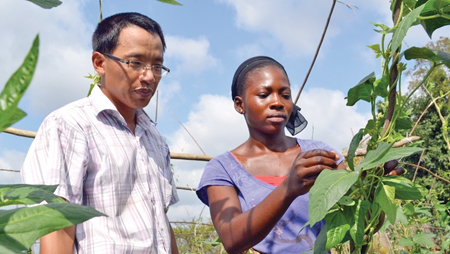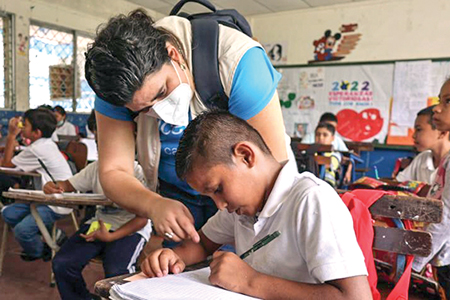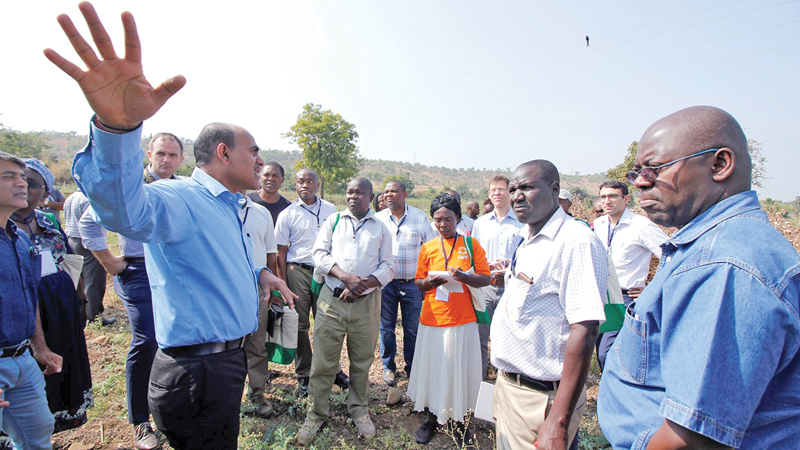 When Sri Lanka faced an economic abyss in 2022, it was countries in the Global South that came to its rescue. India was in the lead, with almost US$ 4 billion in urgent financing. This helped Sri Lanka to get back on its feet, after the worst-ever economic crisis in its post-Independence history. A few months before a full-blown economic crisis engulfed Sri Lanka, Bangladesh provided a loan of US$ 250 million to fulfill urgent needs.
When Sri Lanka faced an economic abyss in 2022, it was countries in the Global South that came to its rescue. India was in the lead, with almost US$ 4 billion in urgent financing. This helped Sri Lanka to get back on its feet, after the worst-ever economic crisis in its post-Independence history. A few months before a full-blown economic crisis engulfed Sri Lanka, Bangladesh provided a loan of US$ 250 million to fulfill urgent needs.
These are examples for South-South Cooperation, a term used to denote cooperation between and among developing nations. The “South” is a reference to the fact that almost all countries in the Northern Hemisphere are developed or rich, while countries in the Southern Hemisphere are generally poor, with the exception of Australia, New Zealand, South Korea, Singapore and certain Middle Eastern States.
Wealth of expertise
There are many other examples for South-South cooperation – the Republic of Congo tapping into the wealth of expertise and innovations available in Brazil on family farming and school feeding programs; Cuba’s support in the fight against Ebola in West Africa; UNESCO’s facilitating of exchanges between Fiji, Marshall Islands, Samoa, Solomon Islands, Tonga, Tuvalu, and Vanuatu to build capacities of teachers.
Other notable initiatives include China’s Belt and Road Initiative (BRI), India’s concessional Line of Credit to Africa, the Asian Infrastructure Investment Bank (AAIB), and the Strategic Association Agreement (SAA) by Mexico and Chile, BRICS, a political bloc comprising mainly Global South countries, BIMSTEC (of which Sri Lanka is a member) and the Indian Ocean Rim Association (IORA, currently chaired by Sri Lanka).
There are several interesting aspects of South-South cooperation, which upends the traditional theory of North-South cooperation. This is based on the assumption that rich countries should help their poor cousins and also that poor countries should always turn to their rich counterparts to seek help. This is a fallacy, as South-South cooperation can actually be more fruitful and the results more immediate.
Meeting their mutual development goals
 It is done through a broad framework of collaboration among countries of the South in the political, economic, social, cultural, environmental and technical domains. Involving two or more developing countries, it can take place on a bilateral, regional, intraregional or interregional basis. Through South-South collaboration, developing countries share knowledge, skills, expertise and resources to meet their mutual development goals through concerted efforts.
It is done through a broad framework of collaboration among countries of the South in the political, economic, social, cultural, environmental and technical domains. Involving two or more developing countries, it can take place on a bilateral, regional, intraregional or interregional basis. Through South-South collaboration, developing countries share knowledge, skills, expertise and resources to meet their mutual development goals through concerted efforts.
For example, the Philippines, through the International Rice Research Institute (IRRI) based in Manila, sends rice experts to other countries in the Global South to experiment on higher-yielding, disease resistant rice varieties.
Another modality of South-South cooperation is Triangular cooperation, a collaboration in which traditional (Western) donor countries and multilateral organisations facilitate South-South initiatives through the provision of funding, training, technology transfer, management and technological systems, as well as other forms of support.
The objectives of South-South Cooperation as defined by the United Nations (UN) are to: foster and strengthen the self-reliance of developing countries by enhancing their creative capacity to find solutions and technological capacities to their development problems and formulate the requisite strategies to address them; promote and strengthen collective self-reliance among developing countries through the exchange of experiences leading to a greater awareness of common problems and wider access to available knowledge; recognise and respond to the problems and requirements of the Least Developed Countries (LDCs), landlocked developing countries, Small Island Developing States (SIDS) and the countries most seriously affected by natural disasters and other crises, and enable them to achieve a greater degree of participation in international economic and trade activities.
Manifestation of solidarity
In fact, countries of the Global South have contributed to more than half of the world’s growth in recent years. Intra-South trade is higher than ever, accounting for more than a quarter of all world trade. The outflows of Foreign Direct Investment (FDI) from the Global South represent a third of the global FDI flows.
 South-South cooperation is a manifestation of solidarity among peoples and countries of the South that contributes to their national well-being, their national and collective self-reliance and the attainment of internationally agreed development goals, including the 2030 Agenda for Sustainable Development.
South-South cooperation is a manifestation of solidarity among peoples and countries of the South that contributes to their national well-being, their national and collective self-reliance and the attainment of internationally agreed development goals, including the 2030 Agenda for Sustainable Development.
Boosting this collaborative spirit, the UN Office for South-South Cooperation (UNOSSC), promotes and facilitates South-South and triangular cooperation for development on a global and United Nations system-wide basis. The Office works to support countries’ efforts to manage, design and implement South-South cooperation policies and initiatives through the identification, sharing and transfer of successful Southern-generated development solutions.
This UN office is in charge of promoting the International Day of South-South Cooperation (September 12), which this year shares the theme “A better tomorrow through South-South Cooperation.” To mark the importance of South-South cooperation, the UN General Assembly decided to observe this Day on September 12 annually, commemorating the adoption in 1978 of the Buenos Aires Plan of Action for Promoting and Implementing Technical Cooperation among Developing Countries.
If the countries of the Global South get together, there are many challenges that they can face and resolve successfully. Resolving and ending conflicts in many Global South countries from Sudan to Somalia should be the first priority. Other Global South countries apart from Egypt and Qatar should play a bigger role in addressing the War in Gaza, which has claimed more than 40,000 lives so far. War and conflict are major causes for poverty, internal displacement, mass migration and lack of education/employment opportunities. We tend to blame the West for its high military spending, but it is no secret that many developing countries too spend billions of dollars on weapons. These funds can instead be channelled for welfare and development.
Climate Change, another key challenge
Climate Change is another challenge, or rather an existential threat to the very survival of humankind. This is another area where South-South cooperation can result in positive change. For example, the proposed International University for Climate Change Studies in Sri Lanka can attract Global South researchers to work on predictive models and then implement measures to mitigate the effects of Climate Change.
Across the Global South, we have seen remarkable advances. However, progress has been uneven. Extreme poverty, deep inequality, unemployment, malnutrition and vulnerability to climate and weather-related shocks persist. According to the United Nations Multidimensional Poverty Index, 2.2 billion people still live in abject poverty. About 1.4 billion people, the majority in the South, still have no reliable electricity, 900 million do not have access to clean water and 2.6 billion lack adequate sanitation.
 Millions of youth and children still lack access to education, which was exacerbated by the pandemic. In fact, the Global South must be ready for the next pandemic, which could be even worse, having learned a bitter lesson from the hoarding of vaccines by the Global North or the First World during the Covid-19 pandemic. If the Global South had the ability to produce their own vaccines and generic alternatives to medicines such as Paxlovid, the death toll could have been much lower.
Millions of youth and children still lack access to education, which was exacerbated by the pandemic. In fact, the Global South must be ready for the next pandemic, which could be even worse, having learned a bitter lesson from the hoarding of vaccines by the Global North or the First World during the Covid-19 pandemic. If the Global South had the ability to produce their own vaccines and generic alternatives to medicines such as Paxlovid, the death toll could have been much lower.
South-South collaboration and partnerships offer the opportunity to turn these statistics around. The countries of the South can collectively use their growing potential to meet their infrastructural needs and target investments in green technologies and public goods that are critical for sustainable development. Global South cooperation through the International Solar Alliance (ISA) and other such entities in renewable energy alone can provide a lasting solution to the energy crisis experienced by many developing countries.
But South-South cooperation alone cannot solve all the problems of the Global South, because at the end of the day, it cannot muster funds on the scale that the Global North does. If the developed world slashes even one percent from their staggeringly high defence expenditure of almost US$ 2 trillion per year, much of the problems faced by the LDCs and SIDS can be solved. On the contrary, many rich OECD countries have pruned their Overseas Aid budgets and even the contribution to UN agencies and programs. They must abandon this horrid mentality for the greatest good of the greatest number.









